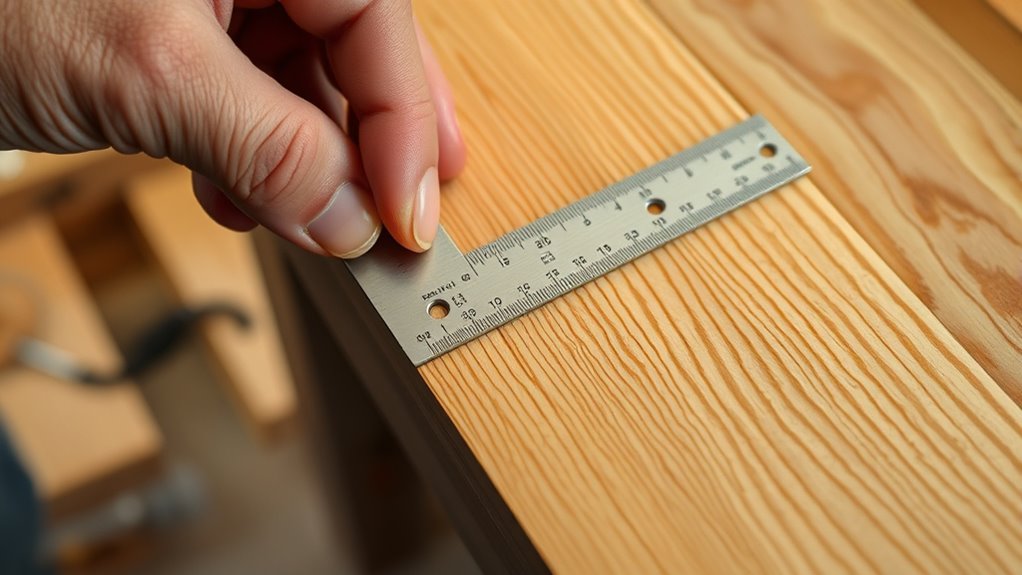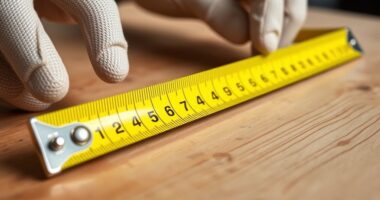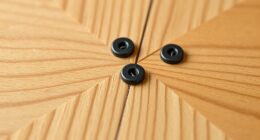To use a double square for precise layouts and depths, start by ensuring it’s properly calibrated against a known standard. Securely lock the blade in position before marking or measuring. Place it carefully on your workpiece, using the visible scales to set accurate angles or depths. Confirm your measurements and double-check for consistency. With proper setup and attention to detail, you’ll achieve professional results—keep exploring to learn how to master every feature for peak accuracy.
Key Takeaways
- Securely lock the blade to ensure accurate, stable measurements during layout marking or depth checking.
- Verify the double square’s calibration regularly against a known standard for reliable precision.
- Use the tool’s marking guides and scribed edges for straight, consistent lines on workpieces.
- Place the double square carefully on the surface, aligning it precisely for accurate layout and depth measurements.
- Confirm measurements by cross-checking with a calibrated standard to prevent errors in critical projects.

A double square is an essential tool for achieving precise layouts and accurate depth measurements in woodworking and construction projects. Its versatility and accuracy make it indispensable when you need to mark out accurate lines, verify angles, or measure depths with confidence. To get the most out of your double square, proper calibration techniques are crucial. Regularly checking the tool against a known standard ensures your measurements stay accurate over time. You can do this by setting the blade against a precision ground surface or a certified square and verifying that the readings match. If discrepancies arise, adjusting the sliding blade or the locking mechanism helps maintain accuracy. Calibration isn’t a one-time process; it’s something you should perform periodically, especially after heavy use or accidental drops, to ensure your measurements remain reliable. Additionally, understanding the contrast ratio of your tools and materials can help you select the best lighting and environment for precise work. Another key aspect of using a double square effectively is its ergonomic design. Many modern double squares are built with features that enhance comfort during prolonged use, such as textured handles, lightweight materials, and easy-to-read scales. When selecting a double square, consider how comfortably it fits in your hand and how smoothly the blade slides without excessive force. An ergonomic design reduces fatigue and allows you to work more precisely, which is vital when you’re making fine measurements or intricate cuts. The smooth movement of the sliding arm also improves your control, helping you align measurements accurately without slipping or misreading.
Using your double square correctly involves more than just placing it on your workpiece. Ensure the blade is securely locked in place before marking or measuring. Double-check your setup by verifying the angle or depth against a known standard or a previous measurement. If your double square features a scribed edge or marking guides, use these to create straight, consistent lines that are crucial for precise joinery or cuts. For measuring depths, position the tool so that the blade extends securely into the area you’re measuring, and double-check your reading to avoid errors caused by misalignment or movement.
Frequently Asked Questions
Can a Double Square Be Used for Metalworking Projects?
Yes, you can use a double square for metalworking projects. It helps you achieve precise measurements and layout lines, essential for accurate cuts and fits. Just remember to perform regular double square maintenance to keep it accurate. Use it for checking angles, depths, or aligning pieces, making your metalworking techniques more precise and efficient. A double square is a versatile tool that enhances your craftsmanship in metal projects.
How Do I Calibrate a Double Square for Accuracy?
Did you know that even a small 1mm deviation can cause significant errors in precision projects? To calibrate your double square, start with calibration techniques like checking against a known flat surface or a certified gauge block. Then, verify accuracy by measuring multiple points. Regular accuracy verification guarantees your tool maintains precision, and if discrepancies are found, re-calibrate or replace the square to keep your measurements reliable.
Is a Double Square Suitable for Woodworking Beyond Layout?
A double square is suitable for woodworking beyond layout because it helps with precision marking and ensuring accurate measurements. You can use it for checking angles, aligning edges, and verifying depths, making your woodworking techniques more precise. Its sturdy construction and reliable measurements help you achieve professional results, especially when you need consistent, accurate cuts and joints. Just remember to keep it calibrated for the best accuracy in all your projects.
What Materials Are Double Squares Typically Made From?
You’ll find double squares are typically made from materials like stainless steel, aluminum, or high-quality hardened steel. These materials guarantee durability and resist wear over time, maintaining their accuracy. Manufacturing precision is vital, so manufacturers carefully craft these tools to strict standards, ensuring your measurements stay true. The choice of material affects both the longevity and performance, making stainless steel and hardened steel popular for professional-level accuracy and lasting reliability.
Can a Double Square Be Combined With Other Measuring Tools?
Yes, you can combine a double square with other measuring tools to enhance your measuring techniques. Use it alongside rulers, tape measures, or calipers to improve accuracy, compare measurements, or verify depths. This integration allows for better tool comparisons, ensuring precise layouts and consistent results. By blending your double square with other tools, you create a versatile measuring system that’s adaptable to various projects and tasks.
Conclusion
Mastering the double square transforms your projects from guesswork to precision. Like a trusted compass guiding your craft, it guarantees every measurement is exact and every cut aligns perfectly. When you embrace this tool, you open a world where accuracy isn’t just an aspiration but a reality. In the dance of craftsmanship, the double square is your steady rhythm—reminding you that precision isn’t just a goal but the very heartbeat of quality.








